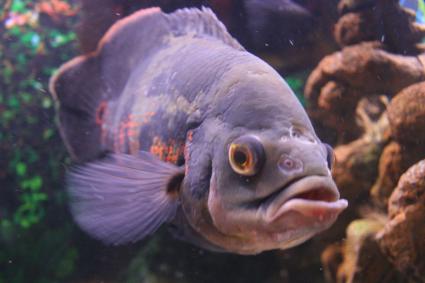
Biting caused goldfish fins to rip, making them vulnerable to illnesses.Īccording to the study, mimic biting occurs when koi fish appear to bite the vicinity of other fish without actually doing so. In the experiment, the author described how koi displayed three different forms of aggressive behaviour when living with fancy goldfish: biting, pretend biting, and chasing. Due to damaged fins and scale loss, your female koi fish may become unwell, especially if the water quality in your pond is poor.Īn investigation of koi’s hostile behaviour versus ornamental goldfish was conducted in 2011. To the extent of harming their scales and fins, they may bite the female koi fish they mate with.
:max_bytes(150000):strip_icc()/GettyImages-992089934-46dfbbd36d864ed58740d211f788653a.jpg)
They are only violent during mating season, which mostly affects male koi fish. Koi fish do not actively pursue smaller fish since they are not hunters.

To keep your equipment functioning at its best, keep up a regular pond cleaning plan. Therefore, you never know when these ancient teeth could appear at the bottom of your pond or in your filter boxes. The moment of a koi’s existence when they prepare for new teeth is not predetermined. Your elder koi fish may shed their tiny, white “teeth” when necessary. Koi teeth are tough enough to eat food, so if you don’t clean your filtration equipment frequently, stray koi teeth might harm your filter material. When your water pump draws water in for filtering, koi teeth can occasionally block your filters. When you perform routine maintenance on your pond, you can find these lost koi teeth there. Koi may shed more than 30 sets of new teeth over their lifespan, as opposed to humans who only lose and regrow teeth once. Like us, koi fish can lose their teeth to create place for new ones. Koi fish are known to recognise owners who feed them frequently, making it unlikely that these creatures will bite the person who feeds them. Otherwise, if you want to get to know your koi fish, you may be confident that it is safe to feed them by hand. If you intentionally handle your koi fish and it tries to escape, you risk getting bitten by it. It’s unlikely that koi bites may cause any unintentional injury to you.

When your koi discover that your fingers are not the most ready-to-eat thing in their mouth, they should be safe from their pharyngeal teeth. Koi also have a propensity to “taste” their food before letting it come in contact with their teeth. When you put your finger in their mouth, you could feel a pull or suction, but it shouldn’t be powerful enough to feel like they’re gnawing. Koi fish don’t have to worry about biting you when you feed them by hand since their teeth are in the rear of their throat. Koi have developed their pharyngeal teeth to grind and smash food into tiny bits for digestion even though they do not chew their food like mammals do. These types of teeth are common in freshwater aquarium fish like goldfish and loaches. The pharyngeal teeth of koi fish extend past their gills and far back into the throat. The primary purpose of koi teeth is covered in this page, along with possible risks to other fish and the entire pond. Although they cannot seriously damage people with their bites, they might pose a hazard to other fish you are rearing alongside them. Koi fish can bite you because they need to eat just like other fish do.

Koi fish have big jaws, so you could find yourself wondering frequently, “Do Koi Fish Bite?” Koi are fish that have enormous, open mouths, especially considering that they may reach lengths of up to 15 inches, and that’s not even the gigantic kind. Koi fish are typically gentle ornamental fish, so part of the enjoyment of growing them is being able to feed them by hand. Koi fish, with their calm presence and colourful personalities, have a remarkable potential to improve the aesthetic value of a property.


 0 kommentar(er)
0 kommentar(er)
